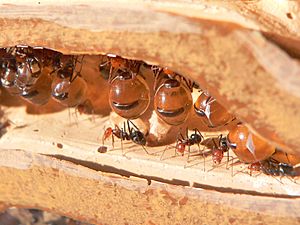Honeypot ant facts for kids
Quick facts for kids Honeypot ant |
|
|---|---|
 |
|
| Honeypot ants | |
| Scientific classification | |
| Kingdom: | |
| Phylum: | |
| Class: | |
| Order: | |
| Family: | |
| Subfamily: |
Formicinae
|
Honeypot ants are amazing ants that act like living food storage containers! They are also called repletes. These special ants are worker ants that cannot have babies. Their job is to store food for the rest of their colony. They do this by letting other worker ants fill their bellies, called abdomens, with food until they swell up like little balloons. There are five main types, or genera, of honeypot ants found around the world.
Contents
What Makes Them Special?
Ants often have different forms within the same species. This is called polymorphism. For example, soldier ants look different from regular worker ants, even though they are genetically the same. How they develop depends on things like the food they eat or special chemicals called pheromones.
How Honeypot Ants Store Food
Young honeypot ants are fed a lot by other worker ants. They are almost "force-fed" until their gasters (which are like their stomachs) become very big and round. Once their bellies are full, they become the living storage vessels for the colony. These special food storage workers are known as repletes.
Flexible Roles in the Colony
Scientists have studied honeypot ants, like the Myrmecocystus mexicanus found in North America. They found that usually the biggest worker ants in a colony become repletes. But if these repletes are removed, other workers will then start to become repletes. This shows how flexible and adaptable these ants are! They can change their roles to help the colony survive.
Why Do Ants Need Food Storage?
Honeypot ants do more than just store food. They can also store liquids, body fat, and water that other worker ants bring to them. This stored supply is super important. It helps feed the other ants in the colony when food is hard to find, like during dry seasons or when there's not much food around.
When the colony needs the stored liquid, worker ants will gently tap the antennae of a honeypot ant. This tapping makes the honeypot ant bring up, or regurgitate, the stored liquid. It's like they're sharing a drink from their own bodies!
Honeypot Ants and Humans
In some places, like the Australian outback, honeypot ants are eaten by people. They are considered a special treat, almost like a sweet candy! People enjoy them as a delicacy.
Images for kids


